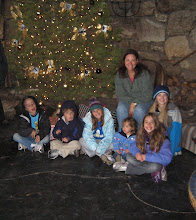Here's a look at what E's. done so far this week in school. E. is the one narrating to me. :)
Monday
In This Country of Ours, we learned about General Braddock who led a lot of English soldiers to try and chase the Indians and French out of English Territories. They marched out into an open field with their vibrant red coats all lined up while the French and Indians were hiding behind bushes blending into their surroundings. The English soldiers were a fair target and they started to shoot at them. George Washington had a lot of bullets shot into his coat, but he didn't get hurt even though he had two horses shot out from underneath him. In the end, General Braddock and almost every English soldier was killed. Washington started an army of his own later and managed to drive the Indians and French out of the English Territories by fighting in their own style.
In George Washington's World, we discovered Benjamin West, the famous American painter. He was invited to visit His Majesty George III. He painted him and the Queen. King George liked his paintings so much he commissioned him to paint paintings for England. After the public saw some of his paintings, they were outraged because the custom of the time was to paint everyone with flowing Greek robes. Even Native American Indians were depicted wearing Ancient Greek dress. Benjamin West said that he thought an artist had a duty to paint things exactly the way he sees them. The King wholeheartedly agreed. We then moved on to learn about Frederick the Great who became known as Frederick The Miser when after the war ended he was trying to raise money to make Prussia great again. He sent away all these people who had been important to his war effort with nothing more than a "goodbye". One of these important men was Baron von Steuben who had been specially trained in the higher tactics of war. Baron von Steuben eventually made his way to America and helped fight w/ the Americans. Meanwhile, in France, King Louis XV was more interested in his own pleasures, the coffers of France were dry and he didn't care. The people of France were poor and starving. The King and his friends came up with a plan to get more money from their already starving people by purchasing all the wheat and grain in the country, storing it in their warehouses until there was a scarcity of food. Then they would sell it back to the people charging them a lot of money for the grain. Louis knew that this couldn't last forever and that the people were becoming more and more discontent. However, he still didn't care and adopted Madame Pompadour's quote "Apres nous le deluge" which means, "After us the deluge!" Saying, "But so long as it comes after I myself am dead, what of it?" At this same time, Maria Theresa of Austria, trying to strengthen Austria's position after the war with Prussia, arranged to have her youngest daughter Marie Antoinette marry the Dauphin (Do fa), the French Crown Prince. Marie Antoinette was a girl who didn't want to do any lessons. All she wanted to do was play all day. When she was 14, she excitedly went to France to meet her husband. She was disappointed when she met her husband, Louis. He was dull, quiet and interested only in making locks and hunting. Marie Antoinette soon discovered she'd have to make her own fun at court.
At about the time Marie Antoinette visited Paris for the first time, Lafayette was also living in Paris. Lafayette had been born in the countryside of France and was raised by his Grandparents. His mother eventually came back for him and brought him to Paris to live with her father. Lafayette's life in Paris was very different from his life in the countryside. He was appointed as a Courtier in the Dauphin's court, but was not happy there. He wanted to be a soldier like his ancestors. His wish to be dismissed from court was granted. In 1775, at the age of 17 he was given a post with a regiment of soldiers in Metz. Through this post, Lafayette would meet with the Duke of Gloucester, brother of George III, which would lead him to America and to help fight for American Liberty.
We also learned about Napoleon Buonaparte, born in Corsica. Corsica had just been taken away from Italy by France the year he was born.
In Madam How and Lady Why we learned how there is a lot of chalk in limestone, which eventually helps to make caves. The water is filled with chalk that goes to the limestone. When the water meets the limestone it digs into it and makes a big cavern. The water that is left in the cave drips off the ceiling. As it drips it makes stalactites because there is a lot of chalk in the water. Stalactites look like stone icicles that hang from the ceiling. The water on the ceiling drips onto the floor of the caves and it builds up forming stalagmites.
We learned about animals which have designs in their bodies like modern inventions we use today. Bats have sonar, there are thermometer birds which keep their nests at the right temperature, baby spiders that fly kites, gazelles have "car radiators" in their heads, keeping their brains cool as their core body temperature increases during flight from predators.
We mourned with Abigail Adams as dysentery plundered Braintree, where the Adam's family lived. John was away at the time with the Continental Congress and was devasted when the news finally reached him.

2 comments:
This is awesome! Very impressive narraration. (sp?) You're doing a great job, mom!
Sally
Once again, I stand amazed Linda! That is some really impressive narration!! Way to go E!
Post a Comment